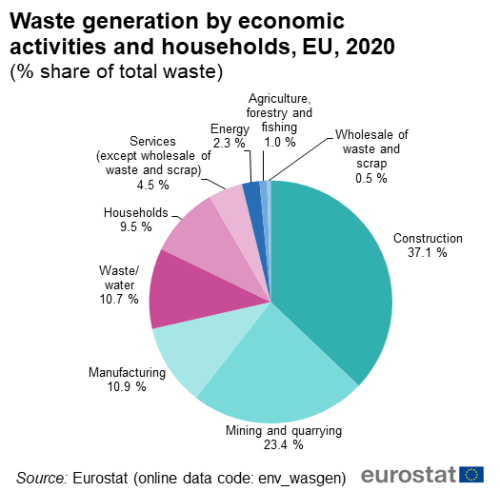In the EU, construction contributed 37.1 % of the total in 2020 and was followed by mining and quarrying (23.4 %), manufacturing (10.9 %), waste and water services (10.7 %), and households (9.5 %). The remaining 8.4 % was waste generated from other economic activities, mainly services (4.5 %) and energy (2.3 %).
A lot of the waste from mining and quarrying and from construction and demolition is classified as major mineral waste. Almost two thirds (64 % or 3.1 tonnes per inhabitant) of the total waste generated in the EU in 2020 was major mineral waste. The relative share of major mineral waste in the total waste generated varied considerably between EU Member States, which may reflect, at least to some degree, different economic structures. In general, those EU Member States that had higher shares of major mineral waste were those that were characterised as having relatively sizeable mining and quarrying activities, such as Finland, Sweden, and Bulgaria, and/or construction and demolition activities, such as Luxembourg. In these member states, major mineral waste accounted for between 84 % and 89 % of all waste generated.
Waste generation, excluding major mineral waste
In the EU, 781 million tonnes of waste excluding major mineral waste were generated in 2020, equivalent to 36 % of the total waste generated. When expressed in relation to population size, the EU generated, on average, 1.7 tonnes per inhabitant in 2020, excluding major mineral waste.
Across the EU Member States, waste generation excluding major mineral waste ranged from an average of 6.3 tonnes per inhabitant in Estonia to less than one tonne per inhabitant in Romania and Malta in 2020. The large quantity of waste generated in Estonia is related to energy production based on oil shale.
In 2020, the highest levels of waste generation were recorded for waste and water services (211 million tonnes), for households (196 million tonnes) and manufacturing activities (171 million tonnes). Their developments followed different patterns over time: between 2004 and 2020, waste generation (excluding major mineral waste) by waste and water services and households increased by 180.4 % and 12.5 %, respectively, while generation by manufacturing activities diminished quite considerably, down by 28.8 %.
Hazardous waste generation
Hazardous waste may pose an elevated risk to human health and to the environment if not managed and disposed of safely. Among the waste generated in the EU in 2020, 95.5 million tonnes (4.4 % of the total) were classified as hazardous waste.
Compared with 2010, 5.1 % more hazardous waste was generated in 2020 in the EU. This is an increase in quantity terms from 90.8 to 95.5 million tonnes with a peak of 101.7 million tonnes in 2018. The decline in 2020 compared to 2018 results mainly from less combustion wastes due to less incineration of solid fuels such as coal, coke, and oil shale. In 2020, the share of hazardous waste in total waste generation was between 0.5 % in Romania and 12.0 % in Bulgaria. Among the non-member countries shown in Figure 4, Turkey recorded the highest share of hazardous waste in total waste generation (28.5 %) and was followed by North Macedonia (28.2 %). Montenegro (27.6 %), Serbia (19.3 %) and Norway (13.3 %).
Waste treatment
In 2020, some 2,029 million tonnes of waste were treated in the EU. This does not include exported waste, but includes the treatment of waste imported into the EU. The reported amounts are therefore not directly comparable with those for waste generation.
The quantity of waste recycled, used for backfilling, or incinerated with energy recovery grew by 40.3 % from 870 million tonnes in 2004 to 1 221 million tonnes in 2020; as a result, the share of such recovery in total waste treatment rose from 45.9 % in 2004 to 60.2 % in 2020. The quantity of waste subject to disposal decreased from 1,027 million tonnes in 2004 to 808 million tonnes in 2020, which was a decrease of 21.3 %. The share of disposal in total waste treatment decreased from 54.1 % in 2004 to 39.8 % in 2020.
As stated above, in the EU in 2020, more than a half (60.2 %) of the waste was treated in recovery operations: recycling (39.2 % of the total treated waste), backfilling (14.6 %) or energy recovery (6.4 %). The remaining 39.8 % was either landfilled (31.3 %), incinerated without energy recovery (0.5 %) or disposed of otherwise (8.1 %). Significant differences could be observed among the EU Member States regarding the use they made of these various treatment methods. For instance, some Member States had very high recycling rates (Italy, Belgium, Slovakia and Latvia), in others landfill is the prevailing treatment category (Romania, Bulgaria, Finland, Sweden and Greece, see Figure 6).
Hazardous waste treatment
In total, 74.3 million tonnes of hazardous waste were treated in the EU in 2020, with more than two thirds of this treated in just four EU Member States, Germany (21.4 million tonnes or 28.5 % of EU total), Bulgaria (13.8 million tonnes or 18.4 %), and France (8.2 million tonnes or 10.9 %) and Sweden (7.0 million tonnes or 9.3 %).
In 2020, 46.8 % of the hazardous waste treated in the EU was recovered: 38.5 % by recycling or backfilling (equivalent to 64 kg per inhabitant) and 8.3 % by energy recovery (14 kg per inhabitant), see Figure 8. The remaining 53.2 % were incinerated without energy recovery (5.9 % or 9.7 kg per inhabitant), landfilled, in other words deposited into or onto land or through land treatment(22.0 % or 36.5 kg per inhabitant) or disposed of by other way (25.3 % or 42.5 kg per inhabitant).











